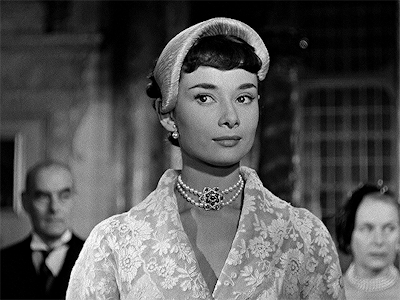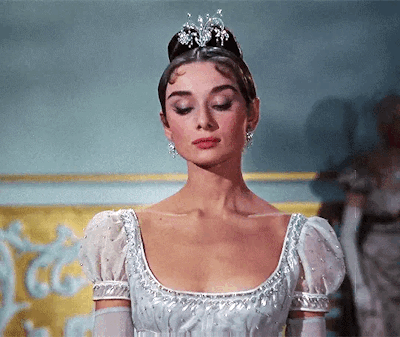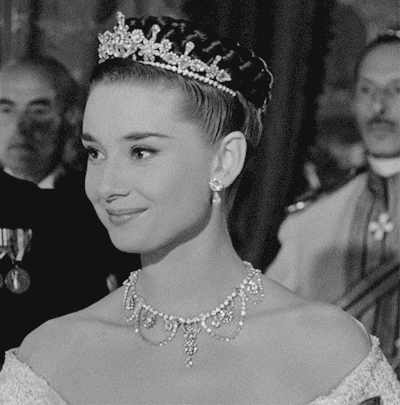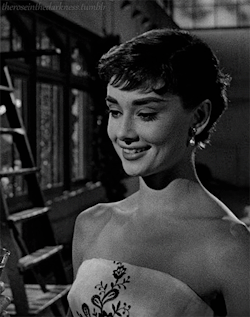WHO NEEDS BEAUTY? Audrey Hepburn's First American Interview From 1954
Audrey Hepburn burst onto the movie scene suddenly and
totally in 1953, starring in her first major film, winning an Oscar out of the
gate, and changing the landscape of Hollywood forever.
And it’s not an exaggeration to say that, from the jump, her
presence caused a stir. Not because she wasn’t talented or stylish, but because
she didn’t look like what a movie star of the era was supposed to look
like.
Take her first American magazine profile, from the January
1954 issue of Photoplay: ‘WHO NEEDS BEAUTY!’
Mike Connolly, a prolific Hollywood reporter of the ‘50s,
spends about 3,700 words in the first issue of 1954 extolling how unconventional
yet beautiful this gamine Dutch actress is and how “the effect she had on this
reporter is nothing short of sensational.”
Let’s back up.
By January 1954, Roman Holiday had premiered,
launching Audrey to a new stratosphere of fame. No longer was she the
background actress in small British pictures, or the Gigi in the eponymous Broadway
musical, or the chorus girl taking dance classes in the hopes of being a ballerina.
She was a bonafide movie star thanks to her turn as Princess Ann, the heir to
an unnamed European country who shirks her duties for one day to do whatever
she wants with Gregory Peck’s journalist.
Her charm and grace and innate talent were apparent from the
start, and a potential Oscar was dangled in front of her from the time the
movie premiered in October 1953. But nobody could explain exactly why
Audrey was such a star. Take Connolly’s word for it: “By Hollywood
standards—and one must never, never minimize Hollywood standards!—Audrey
Hepburn is flat-chested, slim-hipped and altogether un-Marilyn Monroe-ish. Her
measurements are: bust, 32"; waist, 20 1/2"; hips, 34. Nothing
sensational there, is there? And yet, Hollywood standards or no, Audrey Hepburn
is the most phenomenal thing that’s happened to the film capital since Marilyn
Monroe! Figure that out and you’ve got the answer to what makes Hollywood tick.”
Not enough to convince you that this woman was spellbinding?
Here’s Connolly again: “My eyes were watering. The smog was a fiendish
mixture of fire, brimstone, hatpins and feathers. Then Audrey Hepburn glided
into the room and the cloud lifted and my eyes stopped watering.”
And again: “She’s exactly
five-feet-six-and-three-quarter-inches high in her stocking feet, and she moves
those five-feet-six-and-three-quarter-inches around a room like a
cat—gracefully, proudly, a trifle arrogantly—and you sit up and take notice
because her arrival is like a blare of trumpets.”
Now, that’s not to say he didn’t recognize her talent,
because he did compare her to Katharine Hepburn (no relation), Greta Garbo,
Joan Crawford, Greer Garson and Bette Davis—in other words, another legend was
born in Roman Holiday—but Audrey’s natural beauty dominated.
Dominated to the point that Connolly, who had questions
prepared about her ‘relationship’ with Gregory Peck (never happened) and other
personal matters, forgot to ask them when they first sat down. He was too taken
with Audrey’s beauty.
“I sat and let her talk, mesmerized by that exquisite
little-girl face, those hypnotic eyes, exquisite gamin face, those hypnotic
eyes, the most expressive dancer’s hands since Renee Jeanmaire’s, that smile
like a rainbow after a summer shower,” he wrote. “I thought: I should be
more blasé about meeting actresses— after all, I do see and talk to so many of
them on my rounds of the studios and the Sunset Strip salons!—and yet here I
sit staring like a hick from Hicksville, and straining to hear every word
Audrey utters in that throaty, highly mannered half-Dutch, half-English voice,
afraid to miss even a fleeting expression in those constantly moving, uptilted
eyes.”
Eventually, Connolly does get to the point and asks Audrey
his questions, and she’s a dodger that modern celebrities would be proud of.
When he asks about a romantic liaison with Gregory Peck for the first time, she
instead brings up the California smog: “So this is smog! Golly, the fog in
London never affected my eyes like this.”
Then, when pressed again, reminds him that she’s friends
with Gregory’s then-wife Greta, “Does that sound like I’m a home-breaker?”
And for the third time: “I must say, though, that I was
enchanted with Gregory”—she seemed to caress the name as she said it—“because
he was so marvellously normal, so genuine, so downright real! There’s nothing
of the ‘making-like-a-star’ routine, no phoniness in him. He’s down-to-earth,
full of real simplicity, utterly kind to everybody, a gentleman and a real professional
worker.”
Still not satisfied, Connolly asks her how she thinks the rumours
started, that maybe her effusive praise of him started it all? “That could
very well be,” she replies, and that’s that.
For the record: Gregory Peck met his second wife on the set
of Roman Holiday and Audrey Hepburn was engaged to James Hanson, a British
businessman during the shoot. They would later call off the engagement, but Peck
was married to Veronique Passani, an Italian journalist, in 1955.
But back to Audrey Hepburn’s unique beauty, which Connolly
can’t help but focus on. He writes:
“To get back to her physical attributes, her face is the
most enchanting part of this sophisticated imp known as Audrey Hepburn. It’s
oval and high-cheek boned. It’s angular and yet it’s soft.
Looking at her that morning, curled up on the tangerine
sofa in her dressing room, with Photoplay’s photographer, Phil Stern,
flashing bulbs at her, I thought, ‘A very smart cookie…with an air of
untouchableness about her. A fellow will think twice before he grabs hold of
Audrey and tries to kiss her. She’s the kind of girl you want to protect—and
yet she gives the impression that she can take care of herself in almost any
kind of tight squeeze. She’ll either talk herself out of it or slither out of it!
It’s hard to imagine her walking into a room and knocking over a piece of
furniture.’”
There are the talks of her early life— her Dutch/British
upbringing, how the family moved to London following the Second World War, her
dance career, her small film career, how Collette handpicked her for ‘Gigi’…
And her family— her half-brothers, Ian and Alexander, were living
in Indonesia at this point and she was constantly mailing books to them. “They
read an awful lot and Indonesia seems to be very short of books. I am trying to
talk Paramount into finding a script about Indonesia so that I can go over and
make a movie and visit my brothers there.”
Her dominating force of a mother, Baroness Ella van Heemstra—
“She is anything but the ‘typical stage mother.’ Would you believe it, she
has never been to a ballet class or rehearsal of mine! She has never even been
on a movie set of mine. She has never been on location with me—excuse me, she
was once, but just once, and that was only after I begged her to come and fetch
me!”
Her hobbies— “I like to read, play records, swim and
sunbathe. I would love to have a real hobby because everybody asks me if I have
one. I think I’ll have to develop one, a really interesting one—like shrinking
heads! But my trouble is I’m almost always working. I’ve never had both money
and time.”
And about being the ‘next big thing’? “I am tremendously
happy about my success and very grateful when I think about its effect upon all
those wonderful people who have helped me: my mother, my ballet and music
teachers, the producers, directors and choreographers I have worked with, the
people who have put me under contract, the agents who have guided me so wisely,
the other actors and actresses who have advised and helped me—the people like
Gilbert Miller, William Wyler and Gregory Peck.
“But I don’t mean I am satisfied—that would be fatal! I
know that, now that I’ve given what I’m told is a good performance. I’ll be
expected to do at least as well, if not better, in my next picture. I want to
be ready to meet the challenge.”
Of her craft, Connolly writes: “The part Fate played in
bringing Audrey to stage stardom may partially account for her philosophy that
it’s silly to worry about the future. She’s sure that if you do your best every
day and learn all you can about your profession, big things are bound to come
your way. Audrey knows that a star must be a consistently good performer who
knows all the angles of her craft. So she continues to work and study, with
perfection as her goal.”
Audrey followed up Roman Holiday with Sabrina,
starring opposite Humphrey Bogart and one-time love William Holden. She won the
Academy Award for Best Actress on March 25, 1954; she won the Tony for Best Lead
Actress in a Play (for ‘Ondine’) on March 28.
The next year, she was back at the Oscars, nominated again for
Sabrina, and would continue her rise to superstardom with three more
Oscar nominations: 1959’s The Nun’s Story, 1961’s Breakfast at Tiffany’s
and 1967’s Wait Until Dark.
She starred in one of the biggest musicals of the ‘60s, My
Fair Lady, became the first lady of romantic comedies and dreamy Parisian-set
films; a UNICEF Ambassador; she cycled through dramas, comedies, musicals,
epics, biopics, thrillers and mysteries like no one else could. And she focused
on her life outside of Hollywood, quickly settling into life in Switzerland,
spending her days at La Paisible in Tolochenaz until she died in 1993.
She was a fashion maven whose partnership with Hubert de Givenchy
is the stuff of legends. She was voted the most beautiful woman of the 20th
century. She had her own perfume, L’Interdit. She was voted into the International
Best Dressed Hall of Fame in the early ‘60s.
In short, she had the beauty and the grace to match the singular
talents she displayed on the silver screen. As Connolly wrote, back in 1954 comparing
her to Katharine Hepburn, “She is well on her way to living up to the
high-flown predictions that success will smile on her as sunnily as it has
smiled on Katie.”
After spending an article entranced by Audrey Hepburn, Connolly ends it thusly, though you get the sense he kept interviewing her just for the sake of being able to talk to her: “And there you have flat-chested, slim-hipped, altogether un-Marilyn Monroe-ish Audrey Hepburn. But, as Jerry Lewis says—and Jerry works on the same lot with Audrey—‘I like it, I like it!’”






Comments
Post a Comment